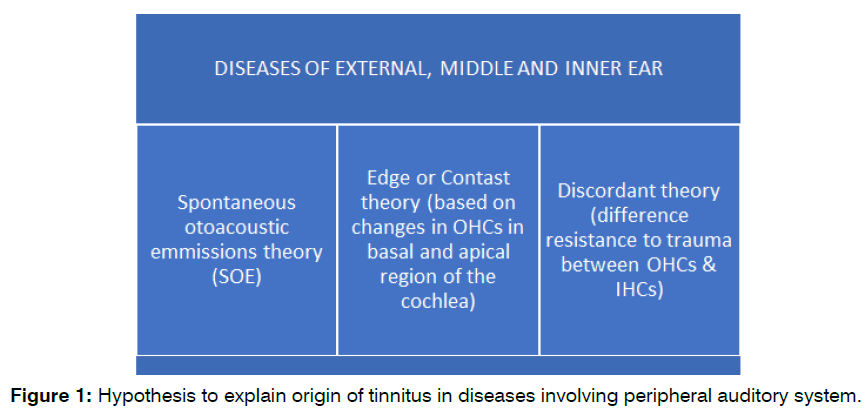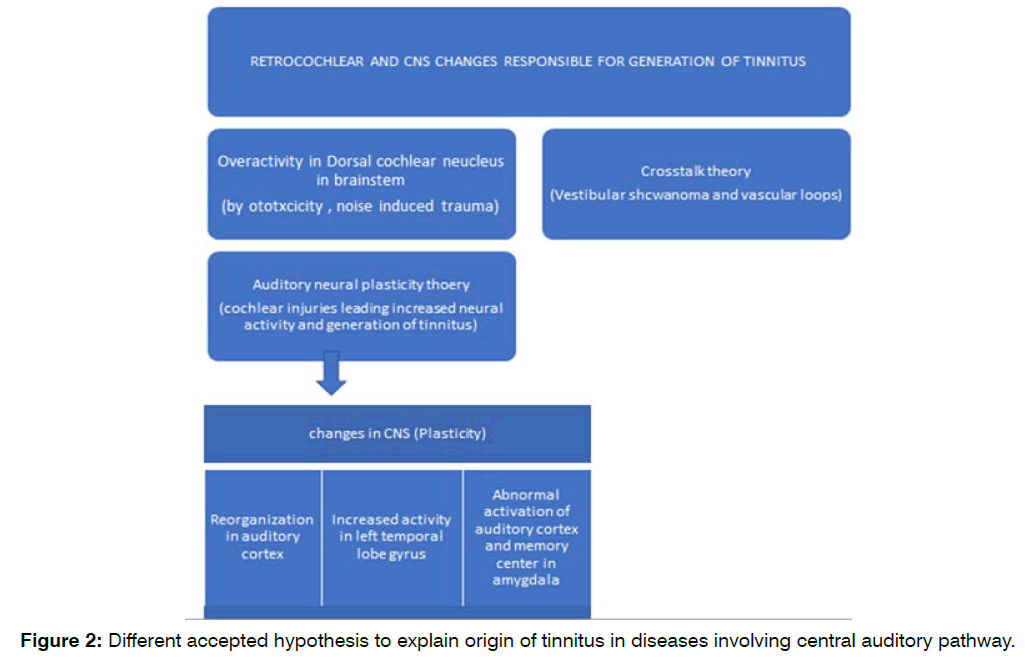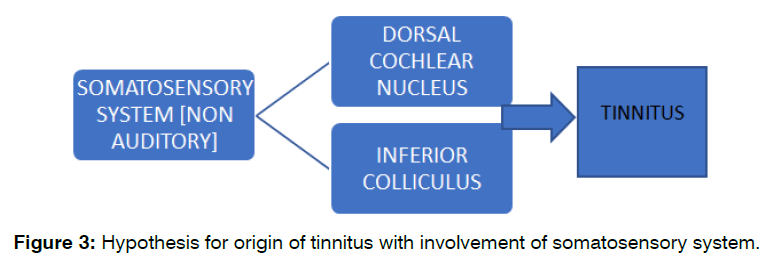The International Tinnitus Journal
Official Journal of the Neurootological and Equilibriometric Society
Official Journal of the Brazil Federal District Otorhinolaryngologist Society
ISSN: 0946-5448

Google scholar citation report
Citations : 12717
The International Tinnitus Journal received 12717 citations as per google scholar report
The International Tinnitus Journal peer review process verified at publons
Indexed In
- Excerpta Medica
- Scimago
- SCOPUS
- Publons
- EMBASE
- Google Scholar
- Euro Pub
- CAS Source Index (CASSI)
- Index Medicus
- Medline
- PubMed
- UGC
- EBSCO
Volume 26, Issue 1 / June 2022
Mini Review Pages:63-67
10.5935/0946-5448.20220009
Tinnitus: Summary of Current Understanding of the Pathophysiology Mechanisms in different Ear Diseases
Authors: Kamlesh Dubey
PDF
Abstract
Introduction: Tinnitus is well known since ancient time with wide prevalence in our community everywhere. Despite advancement in technology, we are far from knowing confirmed Pathomechanism and one treatment of choice for tinnitus. Present review article is an attempt to investigate various pathophysiology mechanisms available, in literature to explain the generation of tinnitus with respect to known diagnoses in which tinnitus is a significant complaint.
Method: Author performed detailed online data search for publications on PubMed, Medline, Google Search, Scopus between 1990-2020. Author’s focus during search was, on the tinnitus and pathophysiology behind the diagnoses involving external ear, middle ear, and inner ear as site of pathology.
Result: Few studies are available explaining likely pathophysiology and mechanism of tinnitus development in diseases involving different subsites of ear.
Conclusion: We still do not know with surety the likely cause behind the generation of tinnitus in various diseases except for objective which are treatable. While rest of subjective type there is no curative treatment available
Keywords: Tinnitus, Pathophysiology, Auditory pathway.
Introduction
Tinnitus is widely prevalent in our community. Studies from United States suggest prevalence of 8% to 25.3% [1-3]. Similar studies from United Kingdom found prevalence of 5.1 % to 42.7% [4]. Further in all the studies of prevalence it has been found that problem is chronic in nature and. Studies from South Korea, Iran found almost similar wide prevalence of tinnitus between 4.6% to 30% [5,6]. Major issue in the prevalence of tinnitus is chronicity and its impact on patient’s overall health including quality of life, with no definite pathophysiologic mechanism behind origin as well as no treatment of choice to advice to every patient.
Definition
Our understanding that tinnitus is not a disease but symptomatic manifestation of disturbance in auditory pathway which include conductive and sensorineural till auditory cortex. Historically tinnitus is known to be derived from Latin word tinnire meaning ringing or to ring. Paparella book on otolaryngology define tinnitus as unwanted auditory perception which has internal origin, usually localized, and heard rarely by others [7]. Proceedings of the Fourth International Tinnitus Seminar, Bordeaux, France in 1992 accepted tinnitus as a noise in ear or head which last for at least 5 minutes, with twice a week interval [8].
Common ear diseases acting as trigger factor in the origin of tinnitus [9-11](Table 1).
| External Ear | Middle Ear | Inner Ear |
|---|---|---|
| Foreign body i.e., cotton bud! | Acute barotrauma | Noise induced trauma |
| Impacted wax | Otitis media (OME, ASOM) | Cochleitis |
| Growth/ Swelling (osteoma, granuloma) | CSOM (Cholesteatoma) | Cochlear neuropathy (any disease causing neuropathy) |
| Discharge | Otosclerosis | Presbycusis |
| Meniere’s disease | ||
| Systemic diseases: Hypertension, CVS, Atherosclerosis | ||
| Hormonal diseases: Hypothyroidism, Hyperthyroidism, DM | ||
| Anaemia (any cause) | ||
| Autoimmune diseases: mechanism include arteritis, neuropathy |
Table 1: Diseases in different subsites of ear presenting with tinnitus complaint.
Pathophysiology of Tinnitus Generation: Various pathophysiologic mechanisms have been proposed to explain origin of tinnitus. Theories try to explain reason for tinnitus generation based on lesion in ear affecting conduction of sound wave:
External ear, Middle ear, Conductive Hearing Loss (CHL) is associated with tinnitus in peripheral causes. Theories for causes affecting central auditory pathway where hearing loss is Sensorineural Type of Hearing Loss (SNHL) on examination.
These theories can be broadly classified in two types:
Patients with Hearing Loss: Neural plasticity has been explained as the reason behind generation of subjective tinnitus [8].
Many theories are available in literature to explain neuroplasticity mechanism which includes (Figure 1):
Figure 1: Hypothesis to explain origin of tinnitus in diseases involving peripheral auditory system.
Peripheral auditory system related hypothesis to explain subjective tinnitus origin:
Spontaneous Otoacoustic Emissions mechanism (SOE) theory: Kemp discussed this hypothesis in an article published in 1981 [9,10]. These are acoustic signals generated by normal cochlear Outer Hair Cells (OHC), which is propagated to external canal. This hypothesis is the reason behind abnormal sound perception in patients with:
External Ear Diseases: Impacted wax, foreign body, otitis externa, tumours.
Middle Ear Diseases: Retraction of tympanic membrane, collection of fluid (OME).
Edge or Contrast Theory: Outer Hair Cells (OHCs) in apical region of organ of corti have an edge over OHCs in the basal region of organ of corti, which would be damaged by ototoxic drugs or intense noise and present with increase in the spontaneous activity leading to changes in peripheral auditory pathway, manifesting in the form or generation of tinnitus [11,12].
Discordant Theory: Both discordant and edge theory try to explain the generation of tinnitus after exposure to a) Ototoxic drugs [13,14], b) Noise [15,16]. In both the conditions Outer Hair Cells (OHC) of organ or corti in cochlea are damaged. The Inner Hair Cells (IHC) group are the source of tinnitus. Studies have shown that IHCs are more resistant to ototoxic drugs and noise induced trauma compared to Outer Hair Cells (OHCs).
Central auditory system-based hypothesis to explain subjective tinnitus origin (Figure 2):
Figure 2: Different accepted hypothesis to explain origin of tinnitus in diseases involving central auditory pathway.
Dorsal Cochlear Nucleus: has been proposed as site for generation of tinnitus particular after exposure to intense noise and chemotherapeutic drugs like cisplatin. Ototoxicity and intense noise damages outer hair cells in cochlea [17,18]. Inadequate OHCs and IHCs sensory supply led to overactivity by dorsal cochlear nucleus in brainstem after neuroplasticity changes [19].
Crosstalk Theory: Tinnitus is one of the major complaints in patient of acoustic neuroma or vestibular schwannoma. This theory tries to explain the generation of tinnitus in these patients. Tinnitus in vascular loops cases in which vessels are compressed, associated with ephaptic coupling, which might lead to tinnitus if synchronization of the stochastic firing in the cochlear nerve is perceived as sound [20,21].
Auditory Neural Plasticity Theory: Neural plasticity, which is ability to change function depending on type and pattern of neural input is well known [21]. Cochlear injuries increase neural activity in central auditory pathway leading to generation of tinnitus [22,23]. Studies have shown increase neural activity in inferior colliculus, amygdala and particularly left temporal lobe in patients having tinnitus as major complaint, during neuroimaging [24,25].
B). Patients without hearing loss (disorders of head and upper neck region): Non-auditory pathomechanisms for generation of tinnitus:
Somatosensory system is also known to affect the normal function of Dorsal Cochlear Nucleus (DCN) and Inferior colliculus and generation of tinnitus [25,26] (Figure 3).
Figure 3: Hypothesis for origin of tinnitus with involvement of somatosensory system.
Temporomandibular joint syndrome, Whiplash injuries [27], reason for the generation of tinnitus in these conditions is injuries to cranial nerves V, VII, IX, X fibres leading to dorsal cochlear nucleus changes sending unregulated signals to central auditory pathway, which will respond in the form of tinnitus [28].
Tinnitus associated with emotional stress, anxiety, and other neurotic disorders:
Limbic system and autonomic system have close anatomical connection with auditory cortex, thalamus, inferior colliculus.
Abnormal neural input from limbic system has been proposed as the reason for generation of tinnitus in patients who have underlying, emotional stress or neurotic issues like anxiety, depression [29-31] (Figure 4).
Figure 4: Connections of limbic system to explain emotional stress and neurotic issues associated with tinnitus.
Conclusion
Jastreboff has described tinnitus as phantom auditory phenomenon. Phantom phenomenon was first described by French surgeon Ambroise Paré (1510–1590) discovered phantom limb phenomenon, in patients who used to complain pain in the amputated limb. Researcher found neuroplasticity mechanism behind this abnormal sensation. Same neuroplasticity or neuro-adaptability when input from peripheral or central auditory pathway is disturbed because of pathologies in external ear, middle ear, cochlea and retrocochlear structures many theories proposed to explain in detail those disturbance led to generation of tinnitus. Another baffling issue in the management of tinnitus when there is no hearing loss and when it is found to arise after episodes of emotional stress, anxiety, and even depression. There are well defined theories to explain above two not so uncommon scenarios. We hope very soon those theories will be more refined, so that we are able to understand and manage the tinnitus problem which is one of the most common chronic problems in community affecting quality of life in every possible way.
References
- KochKin S, Tyler R, Born J. MarkeTrak VIII: The prevalence of tinnitus in the United States and the self-reported efficacy of various treatments. Hear Rev. 2011;18(12):10-27.
- Nondahl DM, Cruickshanks KJ, Wiley TL, Klein R, Klein BE, Tweed TS. Prevalence and 5-year incidence of tinnitus among older adults: the epidemiology of hearing loss study. J Am Acad Audiol. 2002;13(06):323-31.
- Shargorodsky J, Curhan GC, Farwell WR. Prevalence and characteristics of tinnitus among US adults. The Am J Med. 2010;123(8):711-8.
- McCormack A, Edmondson-Jones M, Somerset S, Hall D. A systematic review of the reporting of tinnitus prevalence and severity. Hearing Res. 2016;337:70-9.
- Park KH, Lee SH, Koo JW, Park HY, Lee KY, Choi YS, et al. Prevalence and associated factors of tinnitus: data from the Korean National Health and Nutrition Examination Survey 2009–2011. J Epidemiol. 2014:JE20140024.
- Maryam J, Mohammad F, Alimohamad A, Seyed Kamran K, Ebrahim A, Suzan G, et al. Tinnitus: an epidemiologic study in Iranian population. Acta Med Iran. 2013;51(12):886–891.
- Meyerhoff WL, Cooper JC. Tinnitus. In: Paparella MM, ed. Otolaryngology. 3d ed. Philadelphia: Saunders, 1991:1169-75.
- Dauman R, Tyler RS. Some considerations on the classification of tinnitus. Tinnitus. 1992;91:225-9.
- Han BI, Lee HW, Kim TY, Lim JS, Shin KS. Tinnitus: characteristics, causes, mechanisms, and treatments. J Clin Neurol. 2009;5(1):11-9.
- Møller AR. The role of neural plasticity in tinnitus. Progress in brain Res. 2007;166:37-544.
- Kemp DT. Physiologically active cochlear micromechanics-one source of tinnitus. Tinnitus. 1981:54-81.
- Kiang NY, Moxon EC, Levine RA. Auditory-nerve activity in cats with normal and abnormal cochleas. InCiba Foundation Symposium-Sensorineural Hearing Loss 1970(pp. 241-273). Chichester, UK: John Wiley & Sons, Ltd..
- Baguley DM. Mechanisms of tinnitus. British medical bulletin. 2002;63(1):195-212.
- Stypulkowski PH. Mechanisms of salicylate ototoxicity. Hearing Res. 1990;46(1-2):113-45.
- Cardinaal RM, De Groot JC, Huizing EH, Veldman JE, Smoorenburg GF. Cisplatin-induced ototoxicity: morphological evidence of spontaneous outer hair cell recovery in albino guinea pigs?. Hearing Res. 2000;144(1-2):147-56.
- Emmerich E, Richter F, Reinhold U, Linss V, Linss W. Effects of industrial noise exposure on distortion product otoacoustic emissions (DPOAEs) and hair cell loss of the cochlea–long term experiments in awake guinea pigs. Hearing Res. 2000;148(1-2):9-17.
- Chen GD, Fechter LD. The relationship between noise-induced hearing loss and hair cell loss in rats. Hearing Res. 2003;177(1-2):81-90.
- Levine RA. Somatic (craniocervical) tinnitus and the dorsal cochlear nucleus hypothesis. Am J Otolaryngol. 1999;20(6):351-62.
- Kaltenbach JA, Zhang J, Afman CE. Plasticity of spontaneous neural activity in the dorsal cochlear nucleus after intense sound exposure. Hearing Res. 2000;147(1-2):282-92.
- Kaltenbach JA, Zhang J, Finlayson P. Tinnitus as a plastic phenomenon and its possible neural underpinnings in the dorsal cochlear nucleus. Hearing Res. 2005;206(1-2):200-26.
- Møller AR. Pathophysiology of tinnitus. Ann Otol Rhinol Laryngol 1984; 93:39-44.
- Pascual-Leone A, Amedi A, Fregni F, Merabet LB. The plastic human brain cortex. Annu. Rev. Neurosci.. 2005;28:377-401.
- Salvi RJ, Wang J, Ding D. Auditory plasticity and hyperactivity following cochlear damage. Hearing Res. 2000;147(1-2):261-74.
- RF LA, ML GP. Neuroanatomy of tinnitus. Scand Audiol Suppl. 1999;51:4752.
- Wang J, Ding D, Salvi RJ. Functional reorganization in chinchilla inferior colliculus associated with chronic and acute cochlear damage. Hearing Res. 2002;168(1-2):238-49.
- Reyes SA, Salvi RJ, Burkard RF, Coad ML, Wack DS, Galantowicz PJ, et al. Brain imaging of the effects of lidocaine on tinnitus. Hearing Res. 2002;171(1-2):43-50.
- Kaltenbach JA, Zhang J, Finlayson P. Tinnitus as a plastic phenomenon and its possible neural underpinnings in the dorsal cochlear nucleus. Hearing Res. 2005;206(1-2):200-26.
- Levine RA. Somatic (craniocervical) tinnitus and the dorsal cochlear nucleus hypothesis. Am J Otolaryngol. 1999;20(6):351-62.
- Levin RA. Somatic tinnitus. In: Snow JB. Tinnitus: theory and management. Ontario: BC Decker Inc, 2004;108-124.
- Jastreboff PJ. The neurophysiological model of tinnitus and hyperacusis. Proceedings of the Sixth Inte Tinnitus Seminar. 1999:32-38.
- Jastreboff PJ. Phantom auditory perception (tinnitus): mechanisms of generation and perception. Neurosci Res. 1990;8(4):221-54.
Assistant Professor, Manipal University College Malaysia (MUCM), Melaka, Malaysia.
Send correspondence to: Dr. Kamlesh Dubey K Assistant Professor, Manipal University College Malaysia (MUCM), Melaka, Malaysia, E-mail: drkamleshdubey@gmail.com Phone: +601136728857
Paper submitted on April 08, 2022; and Accepted on May 20, 2022
Citation: Kamlesh Dubey. Tinnitus: Summary of Current Understanding of the Pathophysiology Mechanisms in different Ear Diseases. Int Tinnitus J. 2022;26(1):63-67






